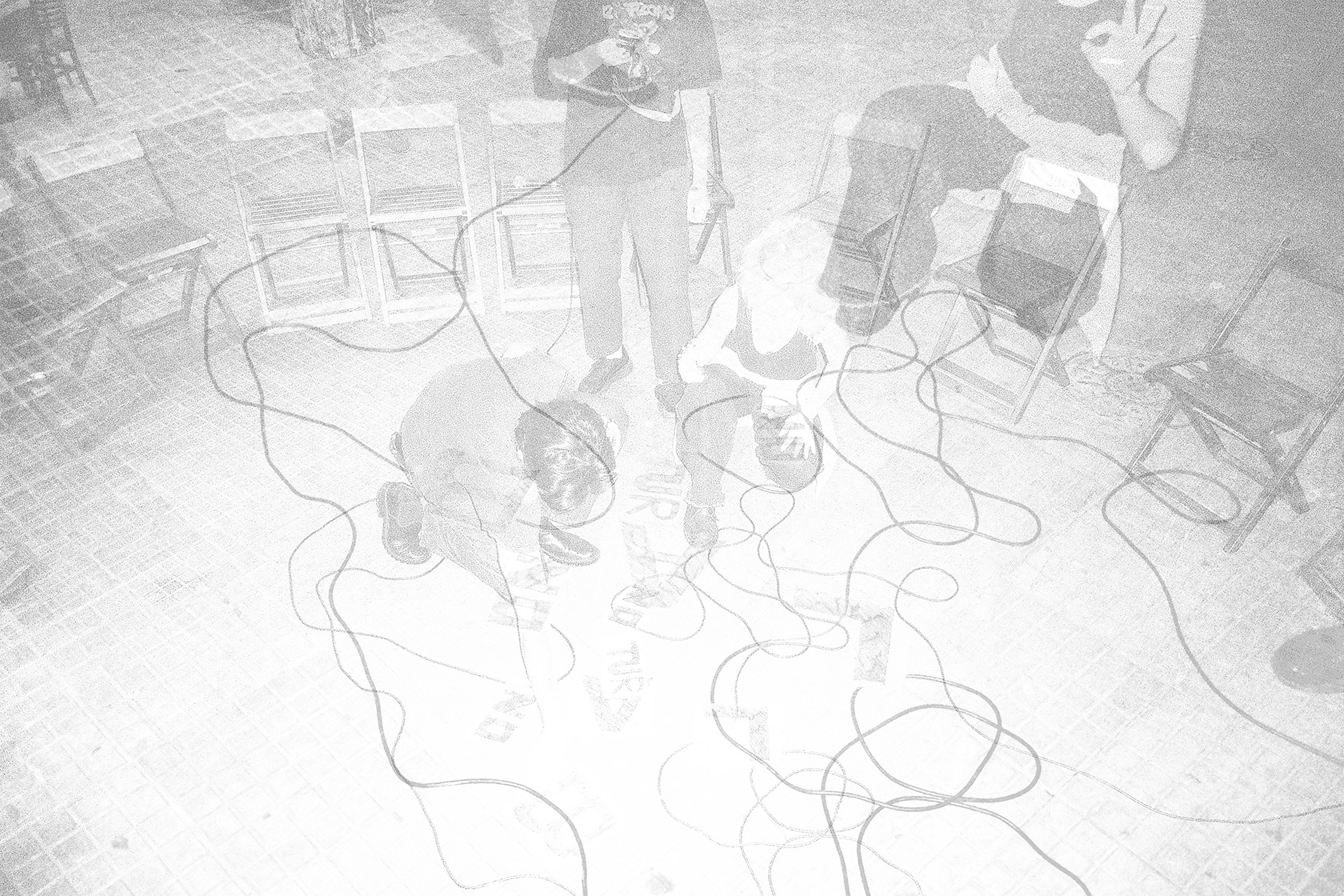still
✹ nocturnal manifest ✹
For those who live, create, and resist at the dark corner of the world
Night is the presence of another order, an expanded time where what is rejected by day gains body, sound, gesture, and space. The night listens to what the day refuses to hear – it darkens to make things feelable, it whispers to conspire.
This manifesto is born from the desire to inhabit that corner, to compose with traces, shines1, and deviations. It does not propose a fixed program, but open experiments, zones of crossing, acts of care, practices of sensitive justice, networks of collaboration.
To be nocturnal is to be affected by the density of the night, to listen to its silence and sounds, to feel its rhythm, to see in its shadows possibilities and technologies of re-existence. It is to refuse the day as the only measure of the world. It is to open new channels of perception. It is to live in counter-time, dissolving the control of time itself.
Ten calls are made below – not as rules, but as flashes - for those who create, experiment, seek refuge, dream, or simply insist – at night:
1. Everything through the experiment
When formulas and frameworks fail, risk remains: to activate the radical potential of experience. Research, language, gesture, theory, space and affect become the raw materials of deviant, vibrant, and open modes of existence. The experiment is a way of life in resistance to standardised being – empirical, intuitive, and technological.
2. Memory of the still
Memory is not solely of the past; it is a structuring, active construction of the present, so the future may become continuous. To record, remember, narrate: these are acts of insurgency in the face of the massive erasure that shapes the histories of our territories. The night writes through traces, fragments, and temporal compositions.
3. Through the darkness, of the night
We present darkness as ethic, as listening, as aesthetic. It is not the absence of light, but the presence of other perceptual forms. After all, the sun is also present at night – reflected in the moon, the tides, in glimmers that escape the spotlight’s logic. We are guided by the nuances of black existences; we learn that darkness can be a fertile ground for liberation.
4. Every place is a place
Night challenges spatial use, dissolving boundaries between categories. Where does freedom dwell? To live at night is to exist even where the body is denied. Every place can be a shelter, encounter, or escape. Every place is a place, but no place is the same – we encounter diverse and infinite topographies.
5. Crawling lives
There are lives that move close to the ground, in the crack, out of focus - lives that have to transmute – subalternized and dissident existences that find in the night a form and a space to exist. The night is their ally.
6. Honouring the unseen
What if an image were a dream, a shadow, a trace? That which escapes the gaze can still be a presence. Honouring the unseen means remaining open to that which cannot be fully captured or visually represented. Vision is not all. To see is also to feel, to remember, to intuit.
7. Shining through
In the opacity of the city, night reveals itself as a space-time of contrast and mystery. The night creates a counter-aesthetic and counter-politics that does not seek to illuminate everything but affirms the strength of reflections – fleeting and ephemeral - a way of seeing and living that honours dissident existences.
8. Registering so as not to disappear
To collect, to keep, to recount. The archive, understood as a living constellation of memories and reconstructed narratives, is both a shelter and a shield. Lost or hidden stories nourish the present. Working with them is also to resist systematic forgetting.
9. Survive: to keep alive is to collaborate, to share
Autonomous and collaborative production is a vital gesture to create in response to, and through, precarity, to weave relationships, suture fragmented parts, and build networks of collaboration. To share, mix, print, speak, exchange, and publish, not as ends in themselves, but as means to remain.
10. Unsubmissive languages
The street conversation, the sketch on a napkin, the dance, the performance, the light, the DJ set, the scream at the party, the listening, the afterexchanges, the thesis: all are knowledge, all are science. Moving across multiple languages is challenging the academic monopoly on knowledge. It is to stimulate resonances through diverse modes of expression.
ainda
✹ manifesto noturno ✹
para quem vive, cria e resiste na esquina escura do mundo
A noite é presença de outra ordem. Um tempo expandido onde o que é recusado pelo dia ganha corpo, som, gesto, espaço. A noite escuta o que o dia não quer ouvir, escurece para tornar sensível, sussurra para conspirar.
Este manifesto nasce do desejo de habitar essa esquina. De compor com os rastros, os brilhos1, os desvios. Ele não propõe um programa fixo, mas experimentos abertos, zonas de travessia, atos de cuidado, práticas de justiça sensível, redes de colaboração.
Ser noturno é ser afetado pela densidade da noite, escutar seu som e silêncio, sentir seu ritmo, ver em suas sombras possibilidades e tecnologias de reexistência. É recusar o dia como única medida do mundo. É abrir canais de percepção. É viver o contraturno dissolvendo o controle do tempo.
Abaixo, dez chamados – não como regras, mas como lampejos. Para quem cria, experimenta, busca refúgio, sonha ou apenas insiste, à noite:
1. Pelo experimento, tudo
Quando fórmulas e programas falham, resta o risco: ativar a potência radical das experiências. A pesquisa, a linguagem, o gesto, a teoria, o espaço e o afeto tornam-se matéria-prima de existências desviantes, vivas, abertas. O experimento é um modo de viver alternativo à padronização do ser – empírico, intuitivo e tecnológico.
2. Memória do ainda
A memória não é só do passado, é construção ativa e estruturante do presente, para que o futuro seja continuidade. Registrar, lembrar, narrar: é insurgência diante do apagamento massivo que descreve as histórias no nosso território. A noite escreve com vestígios, fragmentos, composições de tempos.
3. Pela escuridão, da noite
Escuridão como ética, como escuta, como estética. Não ausência de luz, mas presença de outras formas de percepção. Afinal, o sol também se faz presente na noite – refletido na lua, nas marés, nos brilhos que escapam à lógica do holofote. Nos guiamos pelas nuances das existências pretas, aprendemos que a escuridão pode ser um terreno fértil de libertação.
4. Todo lugar é lugar
A noite desafia o uso dos espaços, dilui fronteiras entre categorias. Onde habita a liberdade? Viver a noite é existir, mesmo onde o corpo é negado. Todo lugar pode ser abrigo, encontro, fuga. Todo lugar é lugar, mas nenhum lugar é igual ao outro – nos encontramos com as diversas e infinitas topografias.
5. Vidas rastejantes
Há vidas que se movem rente ao chão, na fresta, fora do foco.Vidas que precisam se transmutar – existências subalternizadas e dissidentes que encontram na noite uma forma e um espaço para existir. A noite é sua aliada.
6. Honrar o que não se vê
E se uma imagem for um sonho, uma sombra, um vestígio? Aquilo que escapa ao olhar ainda é presença. Honrar o que não se vê é se abrir ao que também não é capturado ou representado visualmente. A visão não é tudo, perceber é também sentir, lembrar, intuir.
7. Brilhar através
Na opacidade da cidade, a noite se revela como um espaço-tempo de contraste e mistério. A noite cria uma contraestética e contrapolítica que não busca iluminar tudo, mas afirma a força dos reflexos, que aparecem por instantes e desaparecem. Um modo de ver e viver que faz justiça à existência dissidente.
8. Registrar para não desaparecer
Coletar, guardar, contar. O arquivo, entendido como constelação viva de memórias e narrativas reconstruídas, é tanto abrigo quanto escudo. Histórias perdidas ou escondidas alimentam o presente. Trabalhar com elas também é resistir ao esquecimento sistemático.
9. Manter vivo é colaborar, compartilhar
Produção autônoma e colaborativa como gesto vital. Criar contra a precariedade, a partir dela. Tecer relações, suturar partes fragmentadas, articular redes de colaboração. Compartilhar, mixar, imprimir, falar, trocar como meios para permanecer.
10. Linguagens insubmissas
A conversa na rua, o rabisco no guardanapo, a dança, a performance, a luz, o set, o grito no baile, a escuta, as trocas do after, as teses: tudo é saber e ciência. Transitar por múltiplas linguagens é insurgir contra o monopólio acadêmico do conhecimento. É estimular ressonâncias em diferentes linguagens.
☾ method ☾
The Lab Noturno proposes a method for creating and experimenting with spaces of collaboration. With rigour and without a defined form, we seek a science that is ‘less about rigid categories and more about what the method can bear, support, and transform’ (McKittrick 2021). We propose a field in motion, built through lived experience. Here, the experiment is not understood as an isolated test, but as a relational practice – a way of being together, of activating situations that allow us to feel, think, and act in common.
Inspired by the concept of laboratory experimentation, we take this systematic process as a method: a mode of investigation that embraces error, surprise, and the unfinished as constitutive elements of testing and prototyping.
Like a soundboard, where different channels interconnect and modulate the final result, our work engages the intersection of people and practices from varied trajectories and areas. Each channel – our primary ones being sound, image, politics, and technology – functions autonomously, yet always in relation, creating provisional compositions that reconfigure with each activation – actions, courses, or publications.
Thus, the Lab Noturno operates as a set of autonomous channels that combine in diverse ways, depending on the confluences and articulations of each experiment. By these, we mean:
~ ~ confluences ~ ~
The context, stimuli, interests, flows2, and vibrations of a particular moment that shape the shared process;
>>> articulations <<<
The actions, interactions, and exchanges of energy that relate and engage people and networks toward a common purpose.
This method resists closure, opening instead to transmission, improvisation, and the desire to create other worlds. In this context, experiments are collaborative spaces of critical elaboration attentive to the subjectivities, spatialities, and forces that move through the night.
☾ método ☾
O Lab Noturno propõe um método para criar e experimentar espaços de colaboração. Com rigor e sem forma completamente definida, buscamos uma ciência que é “menos sobre categorias rígidas e mais sobre aquilo que o método pode suportar, sustentar e transformar” (McKittrick 2021) e propomos um campo em movimento que se constroi a partir da experiência vivida. O experimento, aqui, é entendido não como teste isolado, mas como prática relacional – um modo de estar junto, de ativar situações que nos permitam sentir, pensar e agir em comum. Inspirados na ideia de experimentação em laboratórios, tomamos esse processo como método: uma forma de investigação que admite o erro, a surpresa e o inacabado como partes constituintes dos testes e projetos.
Como uma mesa de som, onde diferentes canais se interconectam e modulam o resultado final, nosso trabalho envolve a interseção entre pessoas e práticas vindas de diferentes trajetórias e atuações. Cada canal – sendo nossos principais o som, a imagem, a política e a tecnologia – atua de modo autônomo, mas sempre em relação, criando composições provisórias que se reconfiguram a cada ativação – ação, cursos e publicações. Assim, o Lab Noturno opera como um conjunto de canais autônomos que podem se combinar de maneiras diversas, dependendo das confluências e articulações para cada experimento. Por estes, entendemos:
~ ~ confluências ~ ~
Se refere ao contexto, estímulos, interesses, fluxos2 e vibrações de um momento que irão direcionar o processo compartilhado.
>>> articulações <<<
São ações, interações e trocas de energia que relacionam e envolvem pessoas e redes para uma finalidade comum.
Esse método não se fecha em uma forma única, mas se abre à transmissão, ao improviso e ao desejo de criar mundos. Nesse contexto, os experimentos tratam-se, portanto, de espaços de colaboração e elaboração crítica atentos às subjetividades, espacialidades e forças que se movem pela noite.
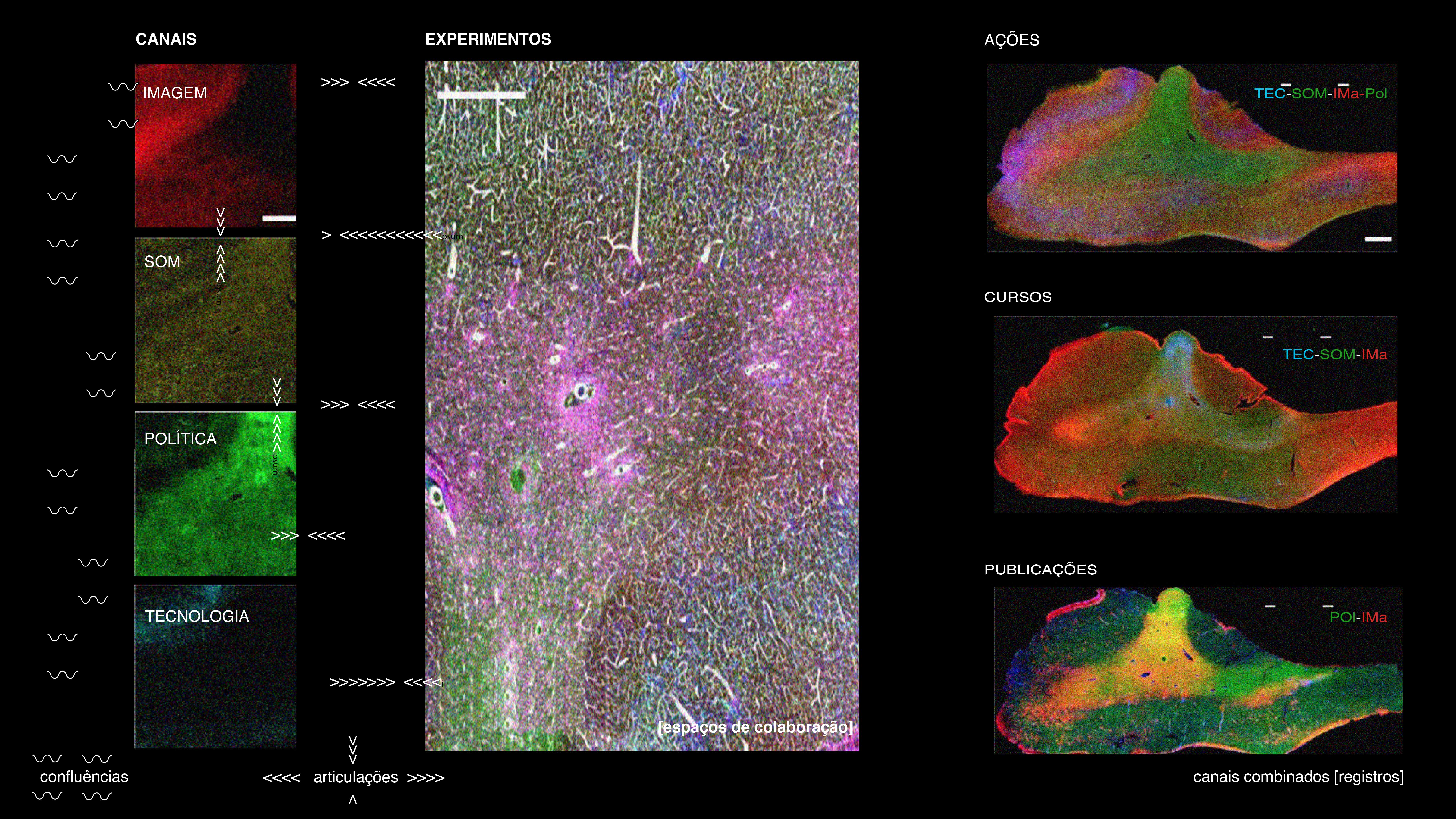
Figure 1: Diagram of the method proposed by the Laboratório Noturno – photomontage from an image sourced from a scientific experiment on cellular tissue. On the left, the channels [image, sound, politics, and technology]; in the middle, the experiments [spaces of collaboration]; on the right, the record of the combined channels [actions, courses, and publications]. Source: Laboratório Noturno, 2024.
Figura 1: Diagrama do método proposto pelo laboratório noturno – fotomontagem a partir de imagem extraída de publicação de experimento científico com tecido celular. Fonte: Laboratório Noturno, 2024.
This essay itself may be considered an experiment – one that records and presents the intentions and practices of the Laboratório Noturno. We draw on materials produced between 2024 and 2025, composed as combined channels emerging from the confluences and articulations of two actions: Espaço de Exceção, which inaugurated the laboratory, and the recording of the podcast Balanço e Fúria.
Este ensaio em si pode ser considerado um experimento que registra e apresenta as intenções e práticas do Lab Noturno. Utilizamos arquivos produzidos entre 2024 e 2025, como canais combinados provenientes das confluências e articulações de duas ações: Espaço de Exceção, que inaugurou o laboratório, e da gravação do podcast Balanço e Fúria.
experiments
◦◉ experiment [1] - space of exception ◉◦
Public action held on August 7 in São Paulo (Brazil).
~ ~ confluences ~ ~
The action was conceived in the context of writer and researcher McKenzie Wark’s presence in Brazil for the launch of her book Technology as Gender and Other Embodied Phenomenologies (Sobinfluencia Edições and Editora Funilaria 2024). This moment connected directly with individual desires and shared concerns that had been circulating among those involved with the Laboratory. Wark’s arrival served as a catalyst: it activated a series of exchanges and movements that quickly coalesced around a collective will to create an open, free gathering, situated in a public space – one capable of broadening access to critical discussions while simultaneously challenging dominant modes of urban occupation.
The desire to carry out this action also stemmed from a pressing need to reflect on our own practices in light of the constraints and violences increasingly imposed on spaces of festivity and gathering in the city of São Paulo. At a time when the city’s urban policy is becoming ever more repressive toward autonomous nocturnal ways of life – through the delegitimisation of independent parties, the criminalisation of peripheral cultures such as bailes funk, and the intensification of real estate-led erasure of social networks – the encounter with Wark became a way of momentarily subverting this landscape. The proposal was to create a “space of exception,” in dialogue with the stories narrated in Raving (Duke University Press 2023), where bodies, voices, and ideas could circulate freely, defying the enclosures imposed by the neoliberal order of the city.
Downtown São Paulo, where the action took place, is at once a site of cultural resistance and of control policies – of social cleansing and expulsion – that determine who may inhabit, circulate, and dwell there, and under what terms. The choice of Banca Corredor Cultural as the site of the action was driven by its role as a convergence point for publishers and cultural projects (Sobinfluencia Edições, Quadrado Círculo), but more importantly, for its capacity to offer an open, non-restricted space of daily circulation – one that, when activated, could transform into a space of open communication.
THIS IS THE CENTER OF SÃO PAULO, A PLACE IN DISPUTE.
ESPECIALLY BECAUSE WE ARE IN A CITY THAT HAS BEEN DESIGNED TO ACCENTUATE INEQUALITIES, THE CENTER REPRESENTS A PRIVILEGED PLACE THAT DOES NOT CORRESPOND TO THE TOTAL REALITY OF THE CITY, WHILE SIMULTANEOUSLY EXPOSING ITS CONTRADICTIONS.
SINCE THE EARLY 20TH CENTURY, WHEN IT WAS URBANIZED, THIS REGION OF REPÚBLICA, KNOWN AS THE 'NEW CENTER,' HAS BEEN A PLACE OF INTENSE NIGHTLIFE WITH CABARETS, 'TOLERANCE HOUSES,' AND BARS – MANY OF THEM MANAGED BY WOMEN.
ON THE STREETS, REPRESSION AND DEATH POLICIES, SUCH AS THE VAGRANCY LAW OF 1941, CRIMINALIZED DRUMMING AND TARGETED CELEBRATIONS PRIMARILY OF BLACK AND INDIGENOUS PEOPLE.
IN THE FOLLOWING DECADES, BETWEEN THE 'MOUTH OF TRASH' AND THE 'MOUTH OF LUXURY,' A 'CULTURAL CORRIDOR' BEGAN TO TAKE SHAPE – FROM LARGO DO AROUCHE TO PRAÇA ROOSEVELT – CONSISTING OF IMPORTANT NIGHTLIFE SPACES AND MEETING POINTS FOR LGBTQIAPN+ COMMUNITIES THAT CONTINUE TO EXIST TODAY.
IT WAS IN THE 2010s THAT THE SCENE OF INDEPENDENT ELECTRONIC MUSIC PARTIES FLOURISHED IN THIS REGION: VOODOOHOP, CAPSLOCK, SELVAGEM, METANOL, MAMBA NEGRA, AND MANY OTHER EVENTS APPROPRIATED PUBLIC SPACES WHILE ALSO CLAIMING POLITICAL SPACE.
DESPITE BEING HISTORICALLY PERSECUTED, DENOUNCED, REGULATED, AND REPRESSED, PARTIES AND OTHER CELEBRATION PRACTICES – ESPECIALLY THOSE CARRIED OUT BY INDIGENOUS, BLACK, AND DISSIDENT PEOPLE – HAVE ALWAYS CONTESTED SPACE IN THE CENTER OF SÃO PAULO.
AMID FORRÓS, PAREDÕES, SOUNDSYSTEMS, BATTLES, BAILES FUNK, AND RAVES, THE NIGHTLIFE IN THE CENTER REPRESENTS SÃO PAULO'S VIBRANT NIGHT SCENE.
IT IS IN THIS PLACE OF DISPUTE, EXCESS, AND EXCEPTION THAT WE FIND OURSELVES TODAY.
Introductory context of downtown São Paulo, inaugural reading of the action, written by Vanessa Mendes, narrated by Léo Felipe.
experimentos
◦◉ experimento [1] - espaço de exceção ◉◦
Ação pública realizada dia 7 de agosto em São Paulo (Brasil).
~ ~ confluências ~ ~
A ação foi concebida no contexto da presença da escritora e pesquisadora McKenzie Wark no Brasil, para o lançamento do livro Tecnologia como Gênero e Outras Fenomenologias Encarnadas (Sobinfluencia Edições e Editora Funilaria 2024). Esse momento se conectou diretamente com desejos e inquietações individuais que vinham sendo compartilhadas entre pessoas vinculadas ao Laboratório. A chegada de Wark foi como um catalisador: ativou uma série de trocas e movimentações que rapidamente se organizaram em torno da vontade coletiva de criar um encontro aberto, gratuito e situado em um espaço público, capaz de ampliar o acesso às discussões e, ao mesmo tempo, tensionar os modos de ocupação urbana.
O desejo de realizar essa ação emergiu também da necessidade de pensar a própria prática à luz dos constrangimentos e violências que se impõem, cada vez mais, sobre os espaços de festa e encontro na cidade de São Paulo. Num momento em que a política urbana paulistana se radicaliza em direção à repressão dos modos de vida noturnos autônomos – com depreciação de festas independentes, criminalização de culturas periféricas como os bailes funk e intensificação da destruição de redes de sociabilização ativada pelo capital imobiliário – o encontro com Wark se tornou uma forma de subverter, mesmo que temporariamente, esse cenário. A proposta foi criar um “espaço de exceção” (Lab Noturno 2024), em diálogo com as histórias narradas em Raving (2023) onde corpos, vozes e ideias pudessem circular livremente, desafiando os cercamentos impostos pela ordem neoliberal da cidade.
O centro de São Paulo, onde a ação aconteceu, é ao mesmo tempo um território de resistência cultural e de políticas de controle, higienização e expulsão, que determinam quem pode estar, circular e morar, e de que modo. A escolha da Banca Corredor Cultural como lugar da ação se deu por ser ponto de convergência entre editoras e projetos culturais (sobinfluencia Edições, Quadrado Círculo e Banca Corredor Cultural), mas principalmente por proporcionar um espaço amplo, sem controle de acesso, de circulação cotidiana e que, quando ativado, poderia se transformar em espaço aberto de comunicação.
ESTAMOS NO CENTRO DE SÃO PAULO, UM ESPAÇO EM DISPUTA.
ESPECIALMENTE POR ESTARMOS EM UMA CIDADE QUE FOI PLANEJADA DE FORMA A ACENTUAR DESIGUALDADES, O CENTRO REPRESENTA UM LUGAR PRIVILEGIADO QUE NÃO CORRESPONDE À REALIDADE TOTAL DA CIDADE, AO MESMO TEMPO QUE EXPÕE SUAS CONTRADIÇÕES.
DESDE O INÍCIO DO SÉCULO PASSADO, QUANDO FOI URBANIZADA, ESSA REGIÃO DA REPÚBLICA, CHAMADA DE 'CENTRO NOVO', JÁ ERA LUGAR DE VIDA NOTURNA INTENSA COM CABARÉS, 'CASAS DE TOLERÂNCIA' E BARES — MUITOS DELES GERENCIADOS POR MULHERES.
NAS RUAS, AS POLÍTICAS DE REPRESSÃO E MORTE, COMO A LEI DA VADIAGEM DE 1941, CRIMINALIZAVAM TAMBORES E PERSEGUIAM CELEBRAÇÕES PRINCIPALMENTE DE PESSOAS PRETAS E INDÍGENAS.
NAS DÉCADAS SEGUINTES, ENTRE A 'BOCA DO LIXO' E A 'BOCA DO LUXO', FOI SE CONFORMANDO UM 'CORREDOR CULTURAL' — DO LARGO DO AROUCHE À PRAÇA ROOSEVELT —, DE ESPAÇOS IMPORTANTES DA VIDA NOTURNA E DE PONTOS DE ENCONTRO DAS COMUNIDADES LGBTQIAP+ QUE SE MANTÉM ATÉ HOJE.
FOI NOS ANOS 2010 QUE A CENA DE FESTAS INDEPENDENTES DE MÚSICA ELETRÔNICA BORBULHOU NESSA REGIÃO: VOODOOHOP, CAPSLOCK, SELVAGEM, METANOL, MAMBA NEGRA E MUITOS OUTROS EVENTOS QUE SE APROPRIARAM DE ESPAÇOS PÚBLICOS REIVINDICANDO TAMBÉM ESPAÇO POLÍTICO.
AINDA QUE HISTORICAMENTE PERSEGUIDAS, DENUNCIADAS, REGULADAS E REPRIMIDAS, FESTAS E OUTRAS PRÁTICAS DE CELEBRAÇÃO, ESPECIALMENTE AQUELAS REALIZADAS POR PESSOAS INDÍGENAS, PRETAS E DISSIDENTES, SEMPRE DISPUTARAM ESPAÇO NO CENTRO DE SÃO PAULO.
ENTRE FORRÓS, PAREDÕES, SOUNDSYSTEMS, BATALHAS, BAILES E RAVES, A NOITE NO CENTRO REPRESENTA A VIDA NOTURNA DE SÃO PAULO.
É NESSE LUGAR DE DISPUTA, DE EXCESSOS, DE EXCEÇÃO QUE NOS ENCONTRAMOS HOJE.
Contexto introdutório do centro de São paulo, leitura inaugural da ação, produzido por vanessa mendes, narrado por Léo Felipe
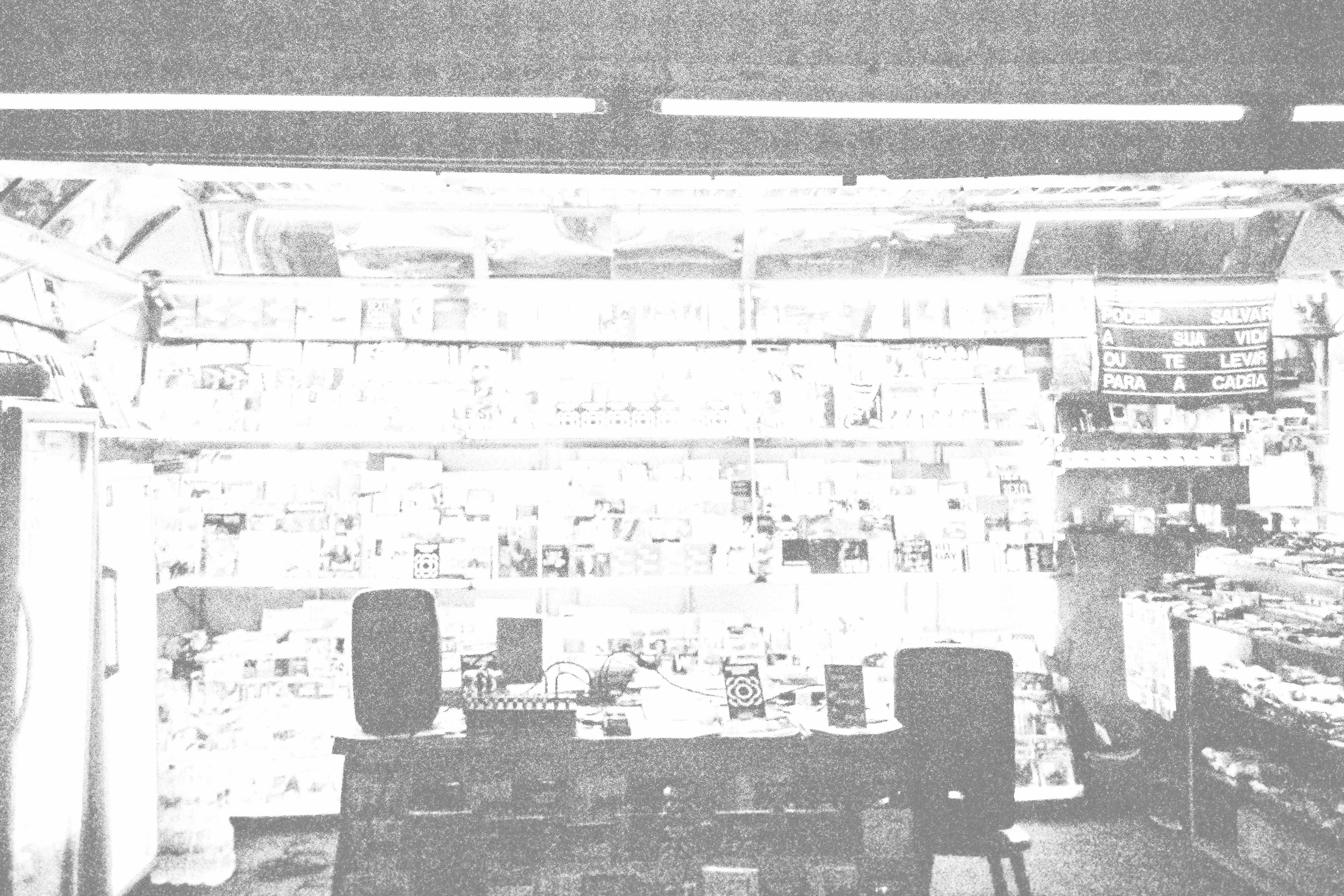
Figure 2: An image captured during the first experiment.
Figura 2: Uma imagem capturada durante o primeiro experimento.
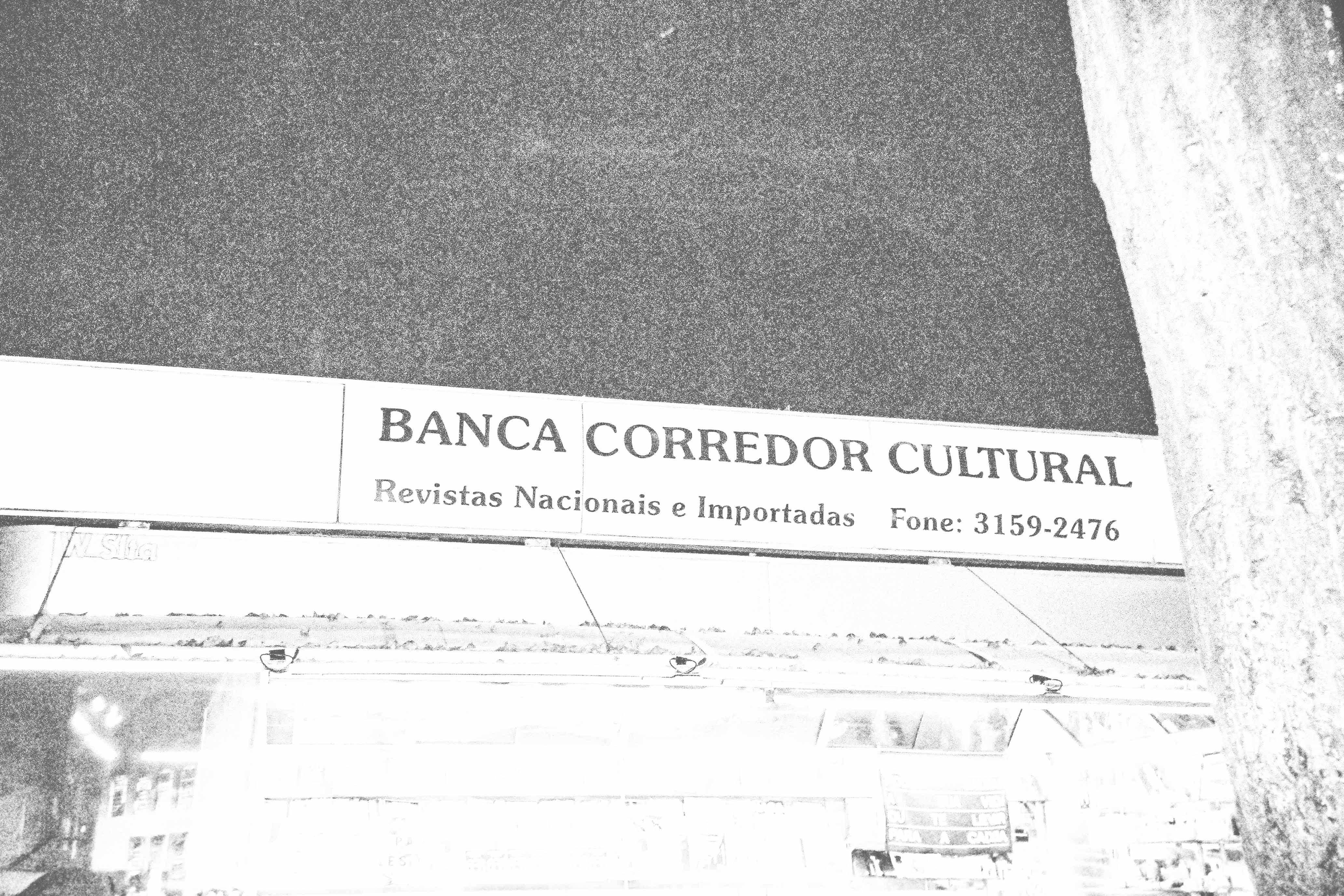
Figure 3: An image capturing downtown São Paulo.
Figura 3: Imagem captando o centro de São Paulo.
>>> articulations >>>
For this experiment Lab Noturno was active with @asa.katerina @cashuuuu_ @chukrilhos @composteira @dvanessinha @estudiomargem @fabiana.gibim @ivimaigabugrimenko @lucas.kroeff @magnificentxseven @mau_schramm @marialuizabr @silvadabanca1 @zi_zii_dj @quadrado.circulo @sobinfluencia @editorafunilaria @revistarosa @kontronatura @laurinduuu @ladyletal @forma.valor
>>> articulações >>>
Para este experimento, o Lab Noturno esteve ativo com @asa.katerina @cashuuuu_ @chukrilhos @composteira @dvanessinha @estudiomargem @fabiana.gibim @ivimaigabugrimenko @lucas.kroeff @magnificentxseven @mau_schramm @marialuizabr @silvadabanca1 @zi_zii_dj @quadrado.circulo @sobinfluencia @editorafunilaria @revistarosa @kontronatura @laurinduuu @ladyletal @forma.valor
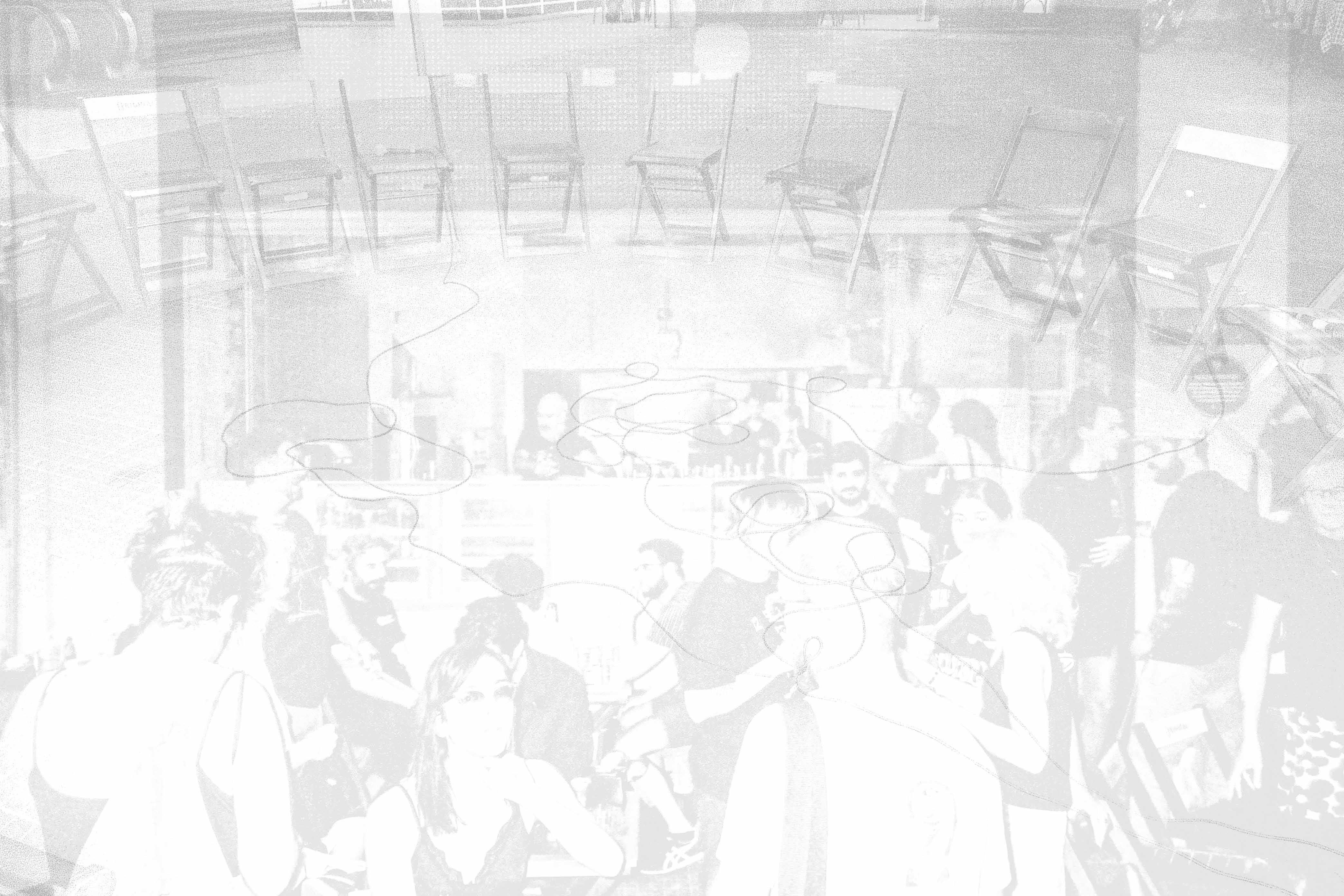
Figure 4: A busy scene captured during the first experiment.
Figura 4: Uma cena movimentada capturada durante o primeiro experimento.
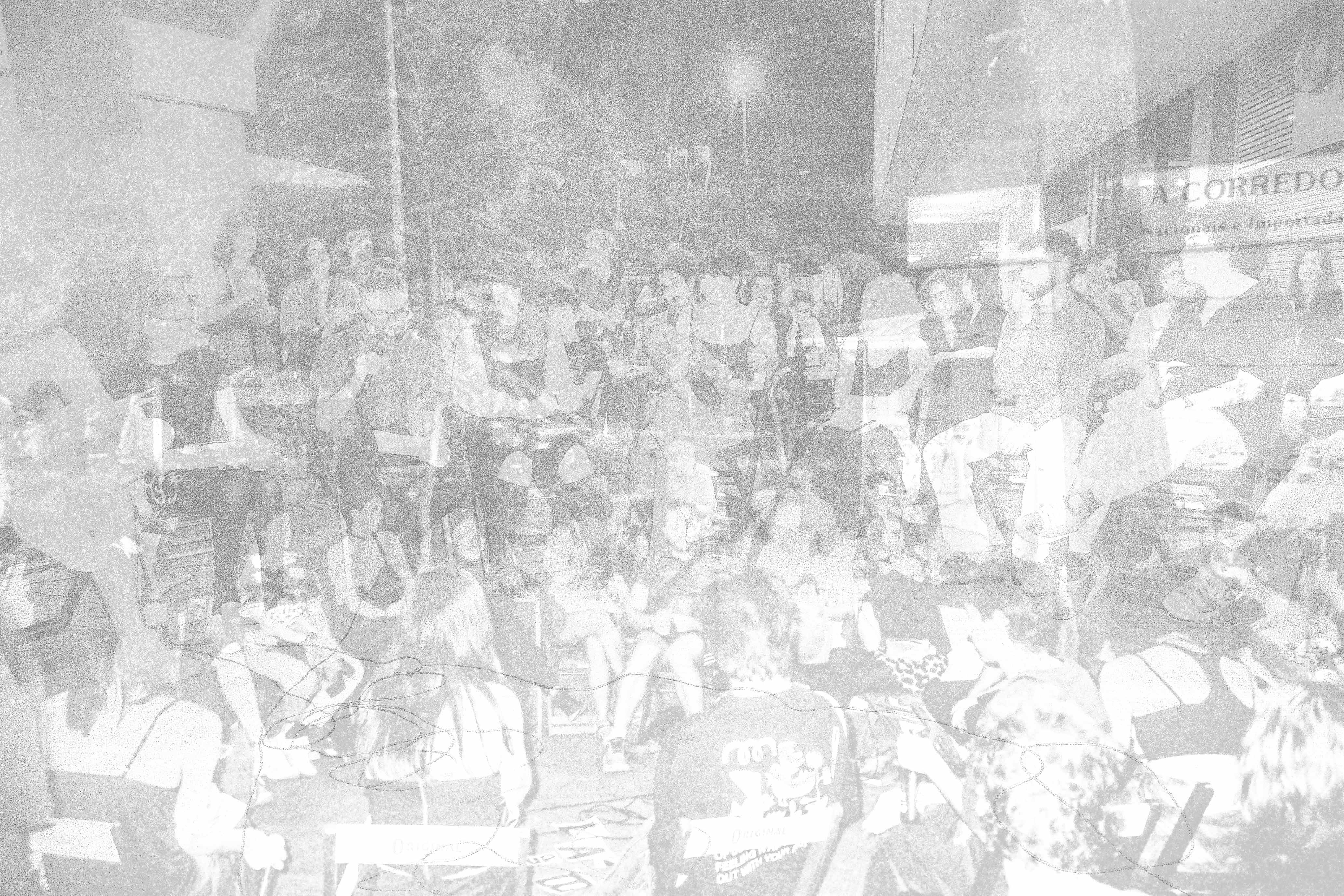
Figure 5: A busy scene captured during the first experiment.
Figura 5: Uma cena movimentada capturada durante o primeiro experimento.
The articulation of the event involved the mobilization, time, and energy of many people: negotiating with nearby bars, borrowing equipment, developing a script and dramaturgy, designing and assembling the space with sound and lighting systems, printing and installing graphic devices – such as photographs, maps, and flags – as well as facilitating, translating, interpreting, and engaging on social media for outreach.
The action was structured in three moments: a conversation around the book, a paju3 with McKenzie Wark, followed by an after-party with Zizi. It functioned as a device for perceiving how the city is shaped by both distance and encounter – and how nocturnal experiences generate microstructures of reflection and resistance that affect how we inhabit other spaces of everyday life.
A articulação envolveu mobilização, tempo e energia de pessoas para acordos com bares do entorno, empréstimo de equipamentos, elaboração de roteiro e dramaturgia, concepção e montagem do espaço com sistemas de som e iluminação, impressão e instalação de dispositivos gráficos — como fotos, mapas e bandeiras—, mediação, interpretação, publicação e interação nas redes sociais para divulgação.
A ação foi concebida em três momentos: conversa em torno do livro, um paju3 com McKenzie Wark e Lab Noturno, seguido de um after party com Zizi. Funcionou como um dispositivo para perceber como a cidade é moldada pelo distanciamento e pelo encontro, e como experiências noturnas produzem microestruturas de reflexão e resistência que impactam a forma como ocupamos outros espaços da vida cotidiana.
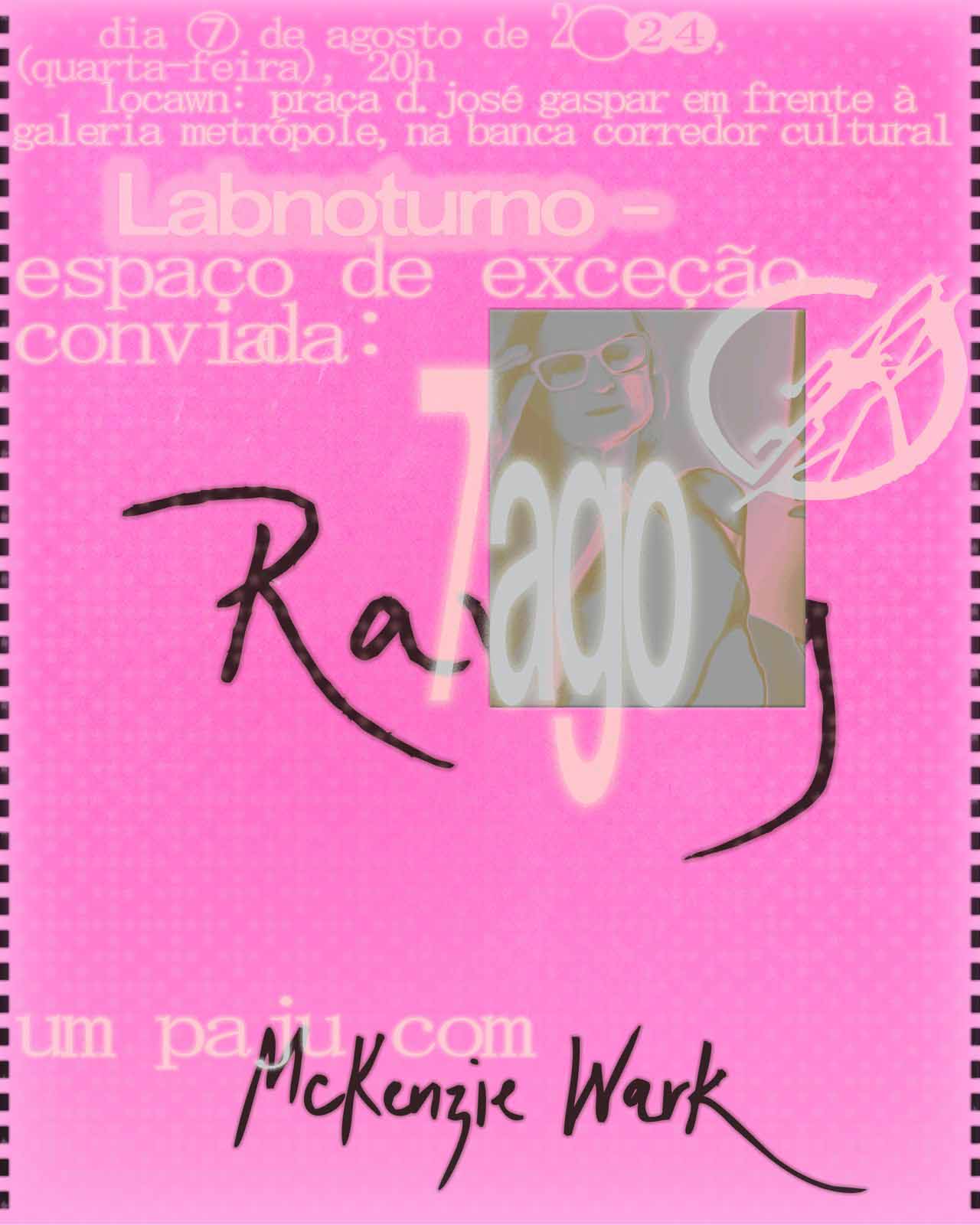
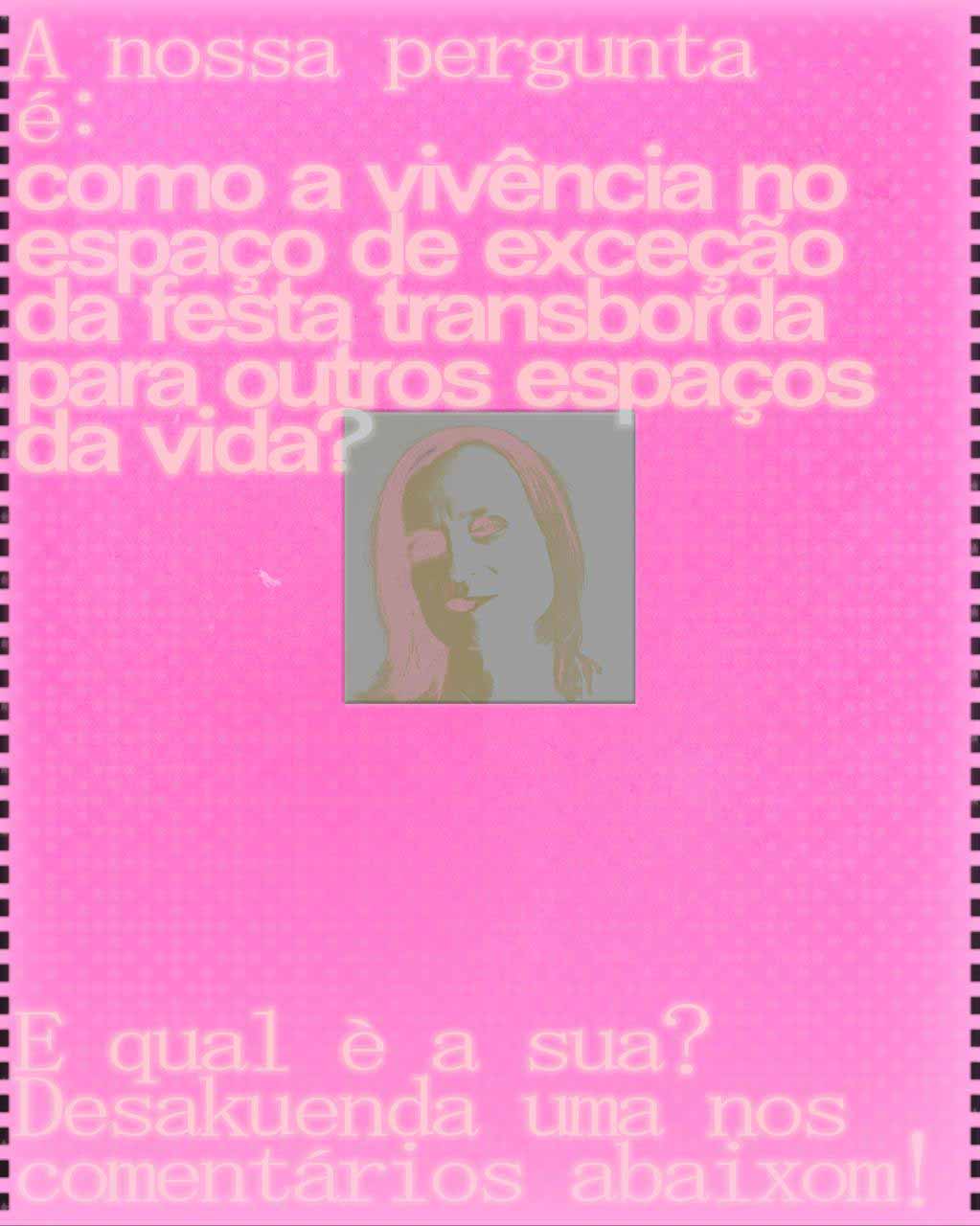
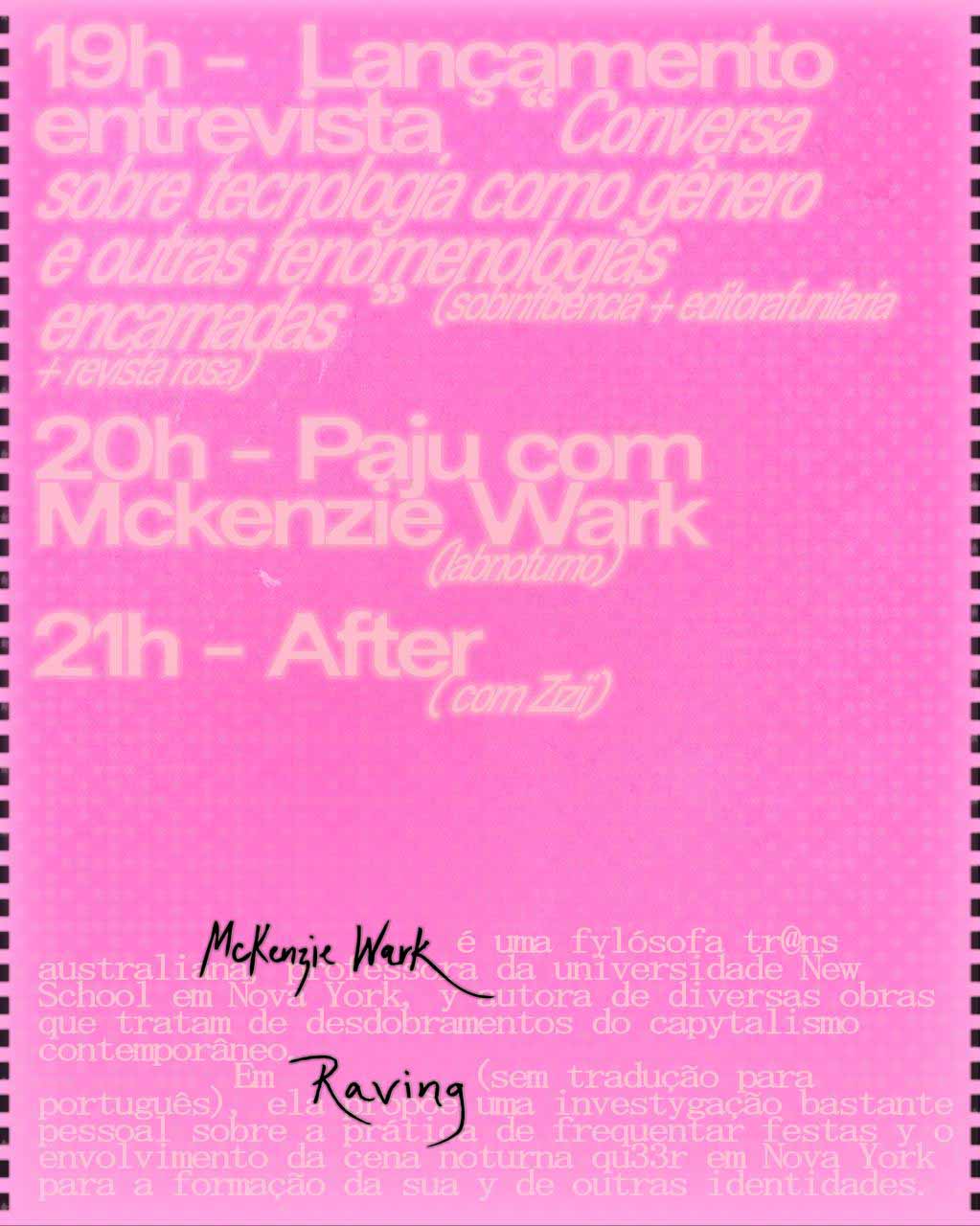
Figure 6-8: Invitation artwork created by Aleksandra Lindenberg and Asa Katerina, posted as a collaborative and interactive announcement via the social media profiles of @labnoturno, @vi.bra.tion, and @mamba.n
The space was designed through resource optimisation and reconfiguration of existing elements: the newsstand became the structural base for the sound and lighting system, while a circle of chairs was opened as a dialogue device – distributing focus and equalising voices. Tubular LED lights with programmed colour sequences were installed across the shelving and roof of the stand. The action was guided by an improvised dramaturgy, where scenes, temporalities, movements, and the rhythm of speech, translation, and listening were sketched in advance. Volunteers offered their time to interpret, translate, and mediate the conversation between the guest and the public.
Figura 6-8: Arte do convite criado por Aleksandra Lindenberg e Asa Katerina, post colaborativo e interativo pelas redes sociais do @labnoturno, @vi.bra.tion, e @mamba.n
O espaço foi desenhado otimizando recursos disponíveis e reconfigurando o uso dos elementos existentes no lugar: A banca de jornal estruturou o sistema de som e de iluminação, a roda de cadeiras foi aberta como dispositivo de diálogo – distribuindo focos e equalizando vozes. Lâmpadas tubulares de led com programação foram instaladas nas prateleirais e marquise da banca. A ação foi organizada a partir de uma dramaturgia improvisada, na qual a cena, tempos, movimentos e ritmos de falas, traduções e escuta foram previamente rascunhados. Pessoas voluntárias se dispuseram a interpretar, traduzir e mediar a conversa entre a convidada e o público.
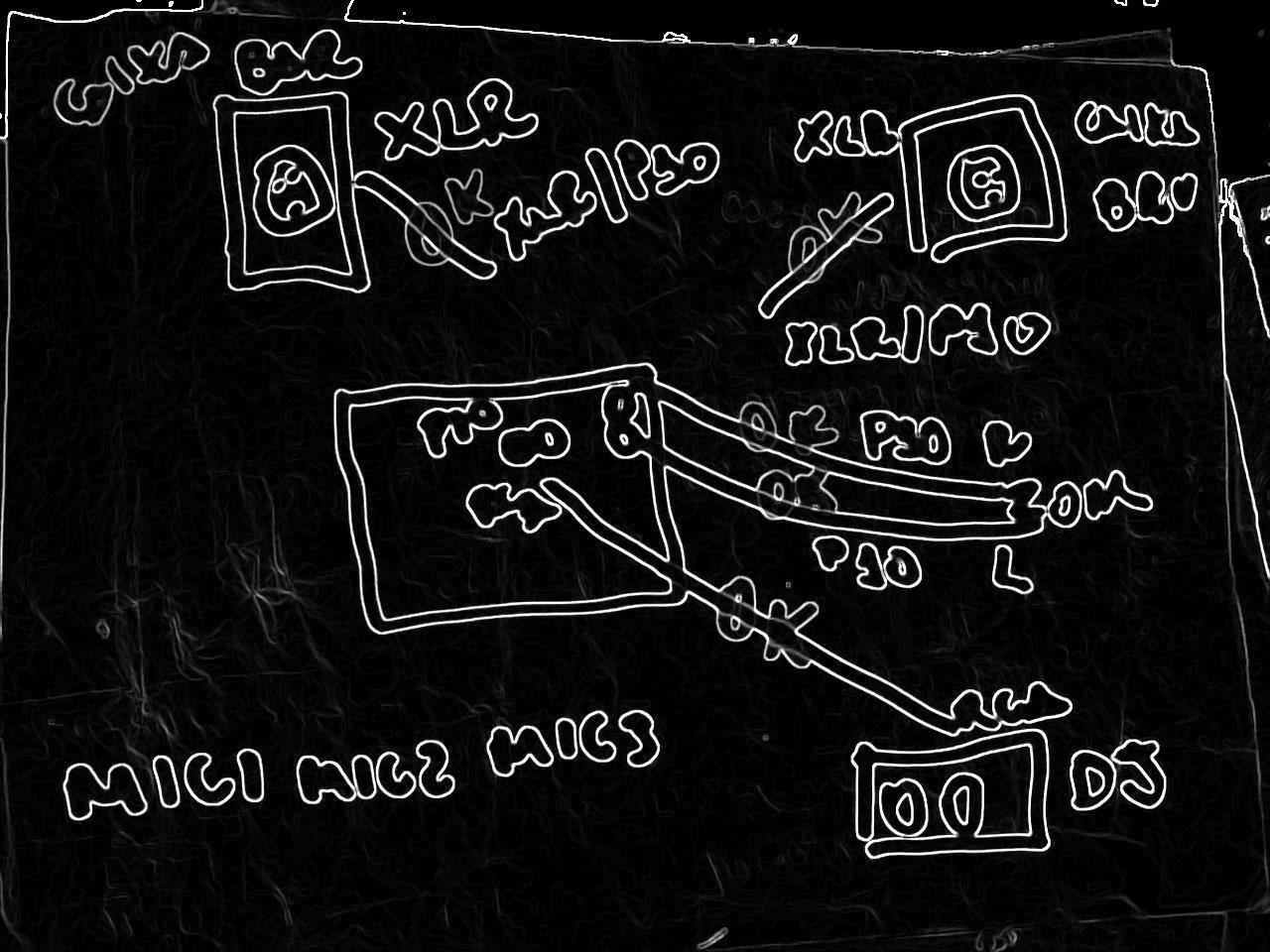
Figure 9: Diagram of the sound setup at the newsstand for the action.
While the action unfolded, the city’s nightlife continued: workers leaving their shifts and waiting for public transport; passersby navigating the downtown streets; bar-goers from nearby establishments drawn in by curiosity, approaching to listen and engage. The experiment emerged through the relation between space, people, and motion – fragments of the conversation reverberated beyond the immediate circle, sparking reflections and displacements.
The central question of the paju was: how does the experience of the party as a space of exception overflow into other spaces of life? This inquiry drew inspiration from McKenzie Wark’s reflections on the creation of spaces where new forms of relation, temporality, and existence can emerge.
For McKenzie Wark, there is an intimacy in the night and in the party that produces networks, contact, and a sense of space that stretches beyond the temporal limits of the night itself. It is not only about resistance, transcendence, or utopia – but about creating a space in which we can simply be, a vibratory state that listens and is carried back into the world as a way of enduring existence.
[Lab Noturno]
We also understand that one of the central dimensions of the night is precisely sound and music. In Raving, McKenzie contextualizes techno music within Black communities. [...] In Brazil, electronic music is also deeply rooted in funk, which shares that same Black origin. [...] Yet we also recognize that funk now appears across numerous musical styles, parties, and festivals around the world – though many of these spaces are predominantly white. This raises a critical question we wanted to ask McKenzie: how does she perceive and interpret these contexts, especially regarding race and the dissonance between the music played and the spaces it occupies?
[McKenzie Wark]
My friend Madison Moore and I co-edited an issue of e-flux that we called Black Rave, and it’s part of that project of continually centering the Black and African origins of these musics. I think of myself as an uninvited guest in that culture [...] But let’s think about how the Black diaspora gave this gift – this very specific kind of music – and how to honor that and center Black producers today. First and foremost, let’s center Black creators, and also queer and trans creators. Yeah, house music in particular – it’s not just Black music, it’s Black gay music.
[Lab Noturno]
From 2010 to 2019, we saw the rise of policies aimed at banning street parties. We don't have a clear sense of how that plays out in cities like New York or elsewhere, but it raised another question for McKenzie: what does she feel about this idea of the space of exception that emerges in the street – not inside the club, but in an open environment, accessible to all, with spontaneous, often unsanctioned interventions?
[McKenzie Wark]
“Yeah, yeah. There are sanctioned street parties in New York, but you have to get permission from the police to close the street. That version exists, and they’re often community-oriented events – and that’s great, right? Just taking over the street. Then there’s what we call renegades, which are illegal street parties – like in the middle of a park at 2 AM, you just set up a sound system. Those became really important during Black Lives Matter and the lockdown. We did that a lot. And I think it mattered – as an extension of protest, as a way of claiming space. During COVID, it also became a way for people to find social spaces relatively safely. Some people really need to be around their people to stay alive. I love it. I love a good renegade. You never know when the police are going to show up to shut it down [...]”.
These transcribed fragments were recorded during the conversation between McKenzie Wark and the Lab Noturno, 2024.
Figure 9: Diagrama de som na Banca para a ação.
Enquanto a ação acontecia, a vida noturna seguia seu curso: trabalhadores deixando seus postos e aguardando o transporte público; pedestres atentos pelo centro; frequentadores dos bares próximos, que, ao perceberem o evento, se aproximavam para escutar e interagir. A experimentação se deu na relação entre espaço, pessoas e movimento: fragmentos da conversa reverberaram para além do círculo imediato, ativando pensamentos e deslocamentos.
A pergunta central do paju foi: omo a vivência de espaço de exceção da festa transborda para outros espaços da vida? Esta reflexão se inspira nas discussões de McKenzie Wark sobre produção de espaços onde formas de relação, tempo e existência se tornam possíveis.
Para McKenzie Wark, há uma intimidade na noite e na festa que produz redes, contatos e um senso de espaço que se estende para além da própria noite. Não se trata apenas de resistência, transcendência ou utopia, mas de criar um espaço onde possamos ser. Um estado vibrátil que se escuta e se leva de volta ao mundo como forma de suportar a existência.
[Lab Noturno]
A gente entende também que uma das dimensões dentro da noite é justamente o som e a música. Em raving, a Mackenzie contextualiza a música techno nas comunidades pretas [...] No Brasil, a gente também tem a música eletrônica pautada muito no funk, que também tem essa mesma origem preta [...] Só que a gente entende também que o funk aparece em diversas músicas, festas, festivais pelo mundo inteiro, só que muitos desses espaços são extremamente embranquecidos. Eu queria perguntar para Mackenzie como ela entende e observa esses contextos, principalmente a questão racial e a dicotomia entre os espaços e a música que toca neles.
[McKenzie Wark]
My friend Madison Moore and I co-edited an issue of e-flux that we called Black Rave, and it’s part of that project of continually centering the Black and African origins of these musics. I think of myself as an uninvited guest in that culture [...] But let’s think about how the Black diaspora gave this gift – this very specific kind of music – and how to honor that and center Black producers today. First and foremost, let’s center Black creators, and also queer and trans creators. Yeah, house music in particular – it’s not just Black music, it’s Black gay music.
[Lab Noturno]
[...] Acho que de 2010 até 2019, né? Quando começaram a querer banir a festa de rua. E eu não tenho ideia de como é isso em Nova York e nem em outras partes do mundo. Mas queria saber de você, o que você sente em relação a esse espaço de exceção que se cria na rua? que não é no clube, que é aberto a todo mundo, que propõe intervenções que são aleatórias.
[McKenzie Wark]
“Yeah, yeah. There are sanctioned street parties in New York, but you have to get permission from the police to close the street. That version exists, and they’re often community-oriented events – and that’s great, right? Just taking over the street. Then there’s what we call renegades, which are illegal street parties – like in the middle of a park at 2 AM, you just set up a sound system. Those became really important during Black Lives Matter and the lockdown. We did that a lot. And I think it mattered – as an extension of protest, as a way of claiming space. During COVID, it also became a way for people to find social spaces relatively safely. Some people really need to be around their people to stay alive. I love it. I love a good renegade. You never know when the police are going to show up to shut it down [...]”.
Fragmentos da transcrição do áudio registrado, Lab Noturno, 2024
Video 1: Atmosphere of the action. Video produced by Mau Schramm with an old digital camera.
Vídeo 1: Vídeo produzido por Mau Schramm com câmera digital antiga, capturando a atmosfera da ação.
◦◉ experiment [2] - counter politics of the night ◉◦
Podcast Balanço e Fúria, recorded in January 2025.
~ ~ confluences ~ ~
This experiment emerged from the encounter between the Balanço e Fúria project and the Lab Noturno, grounded in a shared desire to stimulate thought, experience, and practice around the night as a political space. The conversation, recorded remotely, took place at a moment when the group was seeking to document and share the experiences and reflections it had been developing since its inception. It also offered an opportunity to recognise the very act of registering as a tool for resistance and critical elaboration – especially in light of the speed of information and the saturation of digital content, which often unravel connections, distort theoretical insights, and fragment collective processes.
The urgency of creating and sustaining our own media platforms became clear in this process: these are the spaces where we can test out new languages, slow down content, and prioritise that which moves through and affects us. In this sense, the conversation – transformed into a podcast – also became a space of welcomed-expanded listening, where events and critiques intertwine as ways of thinking through the city, autonomy, and the commons.
The gathering activated different trajectories of people whose practices involve listening, partying, sound, and nocturnal experimentation as fields of political action. More than a podcast episode, the publication was imagined as a breach in the dominant logic of mainstream media – a bet on building narratives through our own pathways: platforms, circuits, and modes of making that escape algorithmic control.
◦◉ experimento [2] - contrapolíticas da noite◉◦
Podcast Balanço e Fúria, realizado em janeiro de 2025.
~ ~ confluences ~ ~
Esse experimento nasce do encontro entre o projeto Balanço e Fúria e o Laboratório Noturno, a partir de um desejo mútuo de estimular os pensamentos, vivências e práticas em torno da noite como espaço político. A conversa, gravada de forma remota, aconteceu num momento em que se buscava registrar e publicar experiências e reflexões que o grupo vinha desenvolvendo desde sua formação. Foi também uma oportunidade de reconhecer o próprio gesto de arquivar como ferramenta de resistência e elaboração – especialmente frente à velocidade da informação e à saturação digital que muitas vezes desarticula os vínculos, desinforma as teorias e desfoca os processos.
A importância de criar e sustentar nossos próprios meios de comunicação se impõe nesse processo: são neles que podemos testar linguagens, desacelerar os conteúdos e priorizar o que nos atravessa. Nesse sentido, a conversa, transformada em podcast, se tornou também um lugar de escuta ampliada, onde acontecimentos e críticas se entrelaçam como formas de pensar a cidade, a autonomia e o comum.
O encontro ativou diferentes trajetórias de pessoas que têm na escuta, na festa, no som e na experimentação noturna um campo de ação política. Mais do que um episódio de podcast, a publicação foi pensada como uma fresta na lógica dominante dos meios de comunicação, apostando na construção de narrativas por vias próprias – plataformas, circuitos, modos de fazer que escapam à lógica do algoritmo.
>>> articulations >>>
For this experiment Lab Noturno was active with @cashuuuu_ @dvanessinha @ivimaigabugrimenko @magnificentxseven @mau_schramm @marialuizabr
Balanço e Fúria is a project created by Rodrigo Corrêa in September 2020, dedicated to interpreting the relationships between culture and politics throughout history, with a particular focus on music. The project also explores other lenses – such as visual arts, photography, and urbanism – addressing themes that circulate within the universe of autonomous and independent practices. It emerged at a time when Brazil was undergoing (and continues to undergo) a political, economic, and cultural depression. The project functions as an exercise in thinking through our present and imagining alternatives for creating life in difficult times, bringing diversity and critical consciousness to the centre of debate. It recognises the potency of these practices – from punk to jazz, from design to pixo, from contemporary art to skateboarding.
The meeting between the project and the Lab gave voice to the episode titled “Counter politics of the Night – between the party, critique, and memory-making with the Lab Noturno.” The episode explored the concept of “counter politics of the night,” investigating how autonomous nocturnal practices can create alternative forms of existence and sociability, challenging the dominant logics of market forces and urban speculation. In this conversation, the night was not merely a metaphor. We spoke of a politics that unfolds in the shadows, in the neglect of those who sleep – one capable of revealing another city beneath the city. Yet, in its literal sense, it is a moment whose resonance does not arrive with daylight.
The intention was to hold an open-ended conversation, flowing between spontaneous crosscurrents and semi-structured axes:
What does it mean to expand the realm of the night – from sound and performance – to one of critical reflection, theory, and knowledge production?
The night as a space of construction: what accumulated experiences inform the creation of these spaces?
The traps of the night – culture and gentrification - between critique and the production of alternatives.
The podcast is available for listening, in Portuguese, on this and other digital platforms.
[Maria Luiza]
“[...] I think there’s a growing interest in understanding what emerges from this counter-time where flows go out of sync. The night brings with it a temporal conflict we don’t choose, as if the day were more productive by convention. But that’s not always the case. There’s an intense life in this counter-time, in this shadowy place, that compels us to seek other forms of knowledge and praxis.”
[Ivi]
“[...] This question of what is considered productive is relative – it depends on one’s work, mind, and rhythm. For many people, it’s the night that allows them to connect with different ideas, when external noise quiets down. That varies a lot from city to city. It also enables different forms of movement and urban dynamics. The night goes beyond the party: it’s what isn’t seen, but is still alive.”
[Cashuu]
“[...] São Paulo is a nocturnal city, but it has no effective policy for the night. Public transport doesn’t function well, some bus lines shut down. The Lab tries to challenge this by amplifying what is already happening – like the parties – but expanding the gaze to include the politics of nightlife itself.”
[Rodrigo]
“[...] Gentrification is an old topic, and it’s true – it was once trendy to talk about it in São Paulo, but now it seems to have slipped out of focus, even though it’s just as fierce as ever. Speculation has extended beyond real estate – it now touches language, symbols, sound, and music. The music produced here is turned into a product for another kind of consumption. I don’t know if the way forward is to reclaim what was once ours or to break entirely and create something new. There’s a strong dispute over symbols and space – maybe it’s time to imagine another horizon.”
[Mau]
“[...] I was going to mention that too. We live under capitalism – inflation, speculation, everything revolves around that. And in the end, even independent initiatives have to deal with those dynamics. At least for our generation, it’s hard to escape completely. The new generations have more breath, time, and willingness to create new things, and that’s important. [...] We live amid intense speculation – over space, value, even what counts as art. The nightlife scene has grown, more artists are able to live from it, but it’s also important to guarantee fair working conditions. [...] And nightlife is always the first to be affected – like it was during the pandemic.”
These transcribed fragments were recorded during the conversation between Balanço e Fúria and the Lab Noturno, 2024.
>>> articulações >>>
Para este experimento, fomos @cashuuuu_ @dvanessinha @ivimaigabugrimenko @magnificentxseven @mau_schramm @marialuizabr
Balanço e Fúria é um projeto criado por Rodrigo Corrêa em setembro de 2020, dedicado a interpretar as relações entre cultura e política ao longo da história, com ênfase na música. Além disso, o projeto se debruça sobre outros recortes, como artes visuais, fotografia e urbanismo, abordando temas que transitam no universo das práticas autônomas e independentes. O projeto surge em um momento em que o Brasil atravessava (e ainda atravessa) uma depressão política, econômica e cultural. Ele tem servido como um exercício para pensar nosso tempo e alternativas para criar vida em um momento difícil, trazendo diversidade e senso crítico para o centro do debate. Para além do podcast, atividades formativas também são desenvolvidas em espaços públicos, que vão de oficinas de mídia livre até Discotecagens Comentadas, que são audições abertas, que partem de um tema ou obra para o desenvolvimento de discussões.
O encontro entre o projeto e o Laboratório Noturno deu voz ao episódio “Contrapolíticas da noite – entre a festa, a crítica e a produção de memória com laboratório noturno". Ele explorou o conceito de “contrapolíticas da noite", investigando como práticas noturnas autônomas podem criar formas alternativas de existência e sociabilidade, desafiando as lógicas dominantes do mercado e da especulação urbana. A noite nessa conversa não foi só uma metáfora. Falamos, sim, de uma política que se dá nas sombras, no descuido dos que descansam, capaz de revelar uma outra cidade sobre a cidade, mas que, no seu sentido literal, não tem como momento de reverberação a luz do dia.
A proposta era uma conversa livre, que fluísse entre atravessamentos instantâneos e eixos semi-estruturados:
O que significa ampliar o local da noite enquanto experiência de som e performance para local de produção de reflexão/crítica/teoria?
A noite como lugar de construção: quais as experiências acumuladas na produção desses espaços?
Armadilhas da noite – cultura e gentrificação, entre a crítica e produção de alternativas.
O podcast está disponível para audição, em português, aqui e em outras plataformas digitais.
[Maria Luiza]
“[...] Acho que há um interesse em entender o que emerge desse contraturno em que fluxos se desencontram. A noite traz essa disputa de horários que não escolhemos, como se o dia fosse mais produtivo por convenção. Mas nem sempre é assim. Há uma vida intensa nesse contraturno, nesse lugar de sombra, que nos move a buscar outros tipos de conhecimento e práxis. ”
[Ivi]
“[...] Esse ponto do que é considerado produtivo é relativo – depende do trabalho, da mente, da rotina de cada um. Para muita gente, é a noite que permite a conexão com outras ideias, quando o ruído externo diminui. Isso varia muito de cidade para cidade. Também facilita o deslocamento e outras dinâmicas urbanas. A noite vai além da festa: é o que não é visto, mas está vivo. ”
[Cashuu]
“[...] São Paulo é uma cidade noturna, mas sem política eficaz para a noite. O transporte não funciona bem, algumas linhas de ônibus param. O Laboratório Noturno tenta tensionar isso, trazendo à tona o que já acontece, como as festas, mas ampliando o olhar para a política da vida noturna.”
[Rodrigo]
“[...] Foi falado da gentrificação como um tema antigo, e é mesmo. Já foi moda falar disso em São Paulo, mas parece ter saído do foco – embora esteja tão feroz quanto antes. A especulação deixou de ser apenas imobiliária e se espalhou: linguagem, símbolos, som e música. A música produzida aqui é transformada em produto para outro tipo de consumo. Não sei se o caminho é retomar o que foi nosso ou romper de vez, criar algo novo. Há uma disputa forte pelos símbolos e espaços – talvez seja hora de imaginar outro horizonte.”
[Mau]
“Eu ia falar disso também. A gente vive no capitalismo – inflação, especulação, tudo gira em torno disso. E, no fim, mesmo iniciativas independentes acabam precisando lidar com essas dinâmicas. Pelo menos na nossa geração, é difícil escapar totalmente. As novas gerações têm mais fôlego, tempo e disposição para criar coisas novas, e isso é importante. [...] Vivemos uma especulação forte sobre espaços, valores, até sobre o que é artístico. A cena noturna cresceu, mais artistas conseguem viver disso, mas também é preciso garantir boas condições de trabalho [...] além do que é a vida noturna é sempre a primeira a ser afetada – como foi na pandemia.
This essay is, in itself, an experiment. It is anchored in two central moments to create another: the public action with McKenzie Wark, where the conversation reverberated simultaneously and in parallel with the nighttime flow of downtown São Paulo; and the podcast recording as an internal gesture of collective elaboration. Although distinct in form and audience, both experiments operate as devices of transmission and expanded perception, broadening the scope of the night as a sensitive, political, and creative territory.
The concept of experiment still (or experiment, still) proposes inhabiting the “still” as a non-linear temporality - a time that insists, that pulses even amid exhaustion and the constant attempt to normalise life. To experiment still is to recognize the city’s continuous movement – like a scene that could be suggested by Milton Santos4: a sequence already in motion, that accumulates, repeats, but also reinvents itself. Each person, each gesture, each combination between channels participates in this vibratory continuum that constitutes the urban nighttime every day.
To think of the city through the night is to listen to it on different frequencies, to see it in other gradients. It is to perceive its layers – the verticalities of control and speculation, and the horizontalities of encounters and invention. In collaborative practices, as in lived geographies, there are noises, frictions, oscillations: all fundamental parts of the process. Rather than striving for an ideal of perfect harmony, what emerges is a field of forces that remains active, even if underground or low-frequency.
It is in this way that Lab Noturno finds its practice: a way of doing research and of doing the city by other means. This essay is the Laboratory’s first published text – both a record and a proposition – that shares the hope of continuity.
Este ensaio é, em si, um experimento. Ele se ancora em dois momentos centrais para criar um terceiro: a ação pública com McKenzie Wark, na qual a conversa reverberou simultaneamente e em paralelo ao fluxo noturno do centro de São Paulo; e a gravação do podcast como gesto interno de elaboração coletiva. Apesar das diferenças de forma e público, ambos os experimentos operam como dispositivos de transmissão e percepção expandida, ampliando o alcance da noite como território sensível, político e criativo.
A noção de ainda a experimentar (ou experimento o ainda) propõe habitar o “ainda-instante” como uma temporalidade não linear. Um tempo que insiste, que pulsa mesmo diante do esgotamento e da constante tentativa de normatizar a vida. Experimentar ainda é reconhecer o movimento contínuo da cidade – como uma cena que poderia ser sugerida por Milton Santos4: uma sequência já em curso, que se acumula, se repete, mas também se reinventa. Cada pessoa, cada gesto, cada combinação entre canais participa desse contínuo vibratório que constitui o cotidiano urbano noturno.
Pensar a cidade pela noite é escutá-la em outras frequências, vê-la em outros gradientes. É perceber suas camadas – as verticalidades do controle e da especulação, e as horizontalidades dos encontros e da invenção. Nas práticas colaborativas, como nas geografias vividas, há ruídos, fricções, oscilações: todos elementos fundamentais do processo. Em vez de buscar uma harmonia ideal, o que emerge é um campo de forças que permanece ativo, ainda que subterrâneo ou em baixa frequência.
É assim que o Lab Noturno encontra sua prática: um modo de pesquisar e fazer cidade por outros meios. Este ensaio é o primeiro texto publicado pelo laboratório – ao mesmo tempo registro e proposição – que compartilha o desejo de continuidade.
1 We draw inspiration from the Brazilian philosopher Denise Ferreira da Silva, who suggests that Black Light – as a metaphor for understanding power structures and procedures for breaking from modern substances—causes things to emanate or shine. This thought can be further explored in texts such as “Blacklight,” in Otobong Nkanga: Luster and Lucre, edited by Clare Molloy and Philippe Pirotte. London: Sternberg Press, 2017.
2 We are inspired by the ideas and concept of confluence presented by Antônio Bispo dos Santos (Nego Bispo), a writer and quilombola activist: “A river does not cease to be a river because it confluences with another river. On the contrary: it becomes itself and other rivers, and it grows stronger. When we confluence, we do not cease to be ourselves; we become ourselves and another person.”
3 Paju is a term originating in quilombola communities that denotes a circle of conversation where knowledge is shared in a horizontal and intuitive manner, without hierarchy among participants. It is also a term from Pajubá, a coded language used by the LGBTQIAPN+ community in Brazil.
4 Milton Santos was one of the most influential geographic thinkers of the 20th century, known for his deep critique of urban spatial structures and the dynamics of globalisation. His conception of the everyday as an analytical key is central to understanding modes of life in the city, including at night. Through the notions of horizontalities (flows, encounters, resistances) and verticalities (normative forces, control, power), Milton Santos offers a grammar that allows us to interpret urban space as a field of both struggle and creation.
1 Nos inspiramos na filósofa brasileira Denise Ferreira da Silva, que sugere que a Luz negra – enquanto metáfora para entender as estruturas de poder e procedimento de ruptura da substância moderna – faz com que as coisas emanem ou brilhem. Tal pensamento pode ser aprofundado em textos como “Blacklight,” in Otobong Nkanga: Luster and Lucre, eds. Clare Molloy and Philippe Pirotte. London: Sternberg Press, 2017.
2 Nos inspiramos nas ideias e no conceito de confluência de Antônio Bispo dos Santos (Nego Bispo), escritor e ativista quilombola: “Um rio não deixa de ser um rio porque conflui com outro rio. Ao contrário: ele passa a ser ele mesmo e outros rios, ele se fortalece. Quando a gente confluencia, a gente não deixa de ser a gente, a gente passa a ser a gente e outra gente.”
3 Paju é um termo de origem em comunidades quilombolas que designa uma roda de conversa onde se compartilham conhecimentos de forma horizontal e intuitiva, sem hierarquia entre os participantes. É também um termo do Pajubá, linguagem cifrada da comunidade LGBTQIAPN+ no Brasil.
4 Milton Santos foi um dos pensadores geográficos mais influentes do século XX, conhecido por sua profunda crítica às estruturas espaciais urbanas e às dinâmicas da globalização. Sua concepção do cotidiano como chave analítica é central para compreender os modos de vida na cidade – inclusive à noite. Por meio das noções de horizontalidades (fluxos, encontros, resistências) e verticalidades (forças normativas, controle, poder), Milton Santos oferece uma gramática que nos permite interpretar o espaço urbano como um campo tanto de luta quanto de criação.





